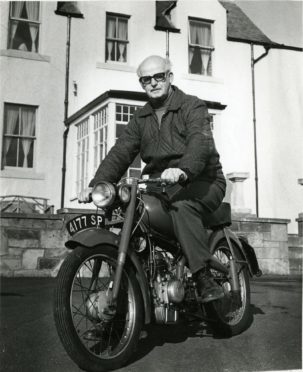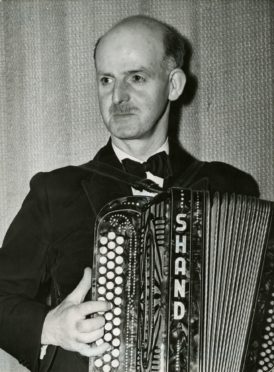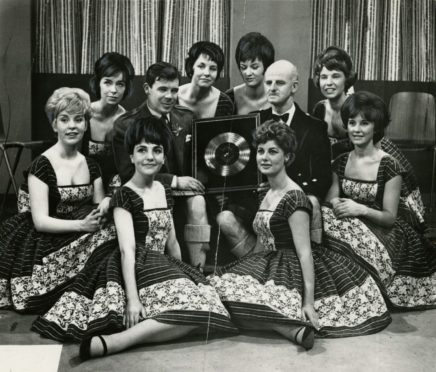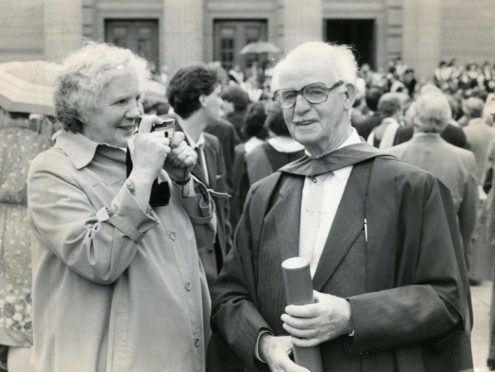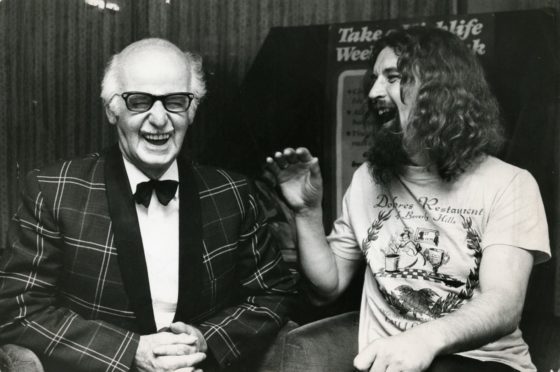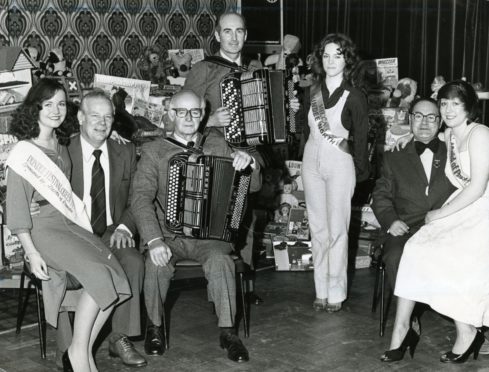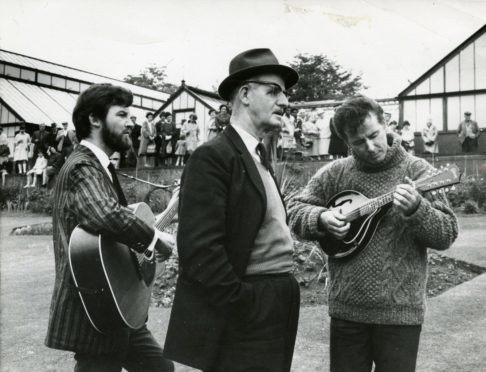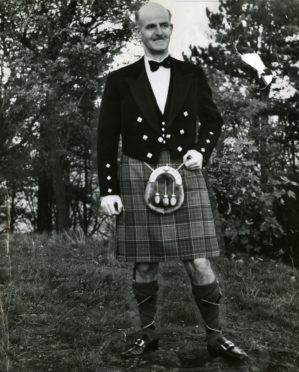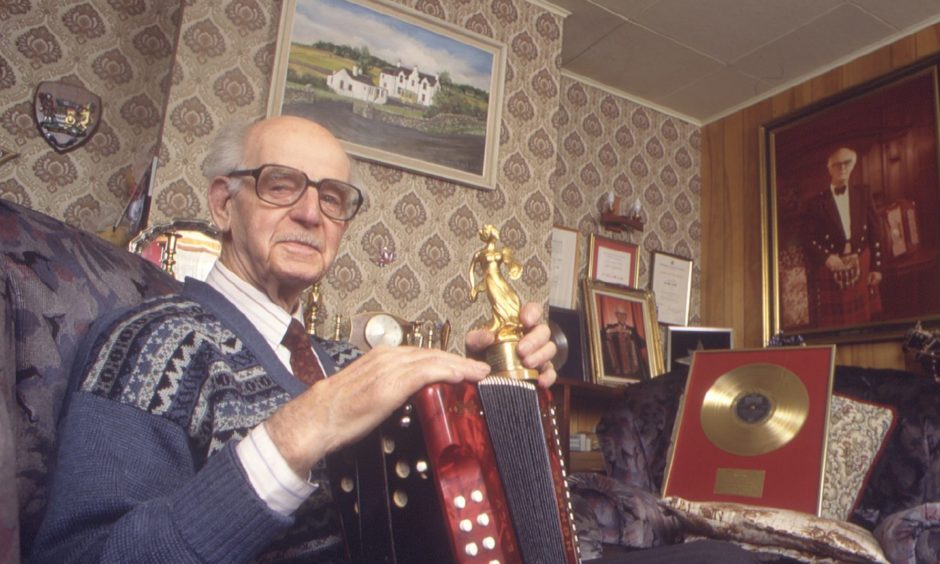
Did Adolf Hitler play an unlikely role in music hero Sir Jimmy Shand’s rise to global stardom?
The Nazi leader is said to have stepped in to allow a German-built accordion to be sent to Sir Jimmy’s home in Dundee in 1939 as war clouds were gathering over Europe.
The former miner from Fife went on to become known as the King of Scottish Dance Music whose recordings sold by the million as he enjoyed worldwide success.
His son Jimmy Jnr suggested Hitler might have helped along the way as he paid tribute to his father who died 20 years ago on December 23 2000 at the age of 92.
The 83-year-old said Sir Jimmy has left behind a rich legacy of style, tempo and compositions which will ensure he is never forgotten.
Early life
Born in East Wemyss in 1908, Sir Jimmy was one of eight children.
The family moved to the burgh of Auchtermuchty where Sir Jimmy was an eager and studious schoolboy before he left for the coal face at the age of 14.
But by then his father had taught him how to play the mouth organ and, more importantly, the accordion.
Later he entertained the communities around his home town of East Wemyss and also developed a liking for fast motorcycles.
But it was the 1926 Miners’ Strike that shaped Sir Jimmy’s life the most.
He played at dances to raise funds, and when the strike ended he didn’t want to go back down the pit.
Instead he worked as a labourer and played at parties and weddings.
But it was a walk in a Dundee street which really made Sir Jimmy.
Looking in a window of the Forbes music shop in King Street with his pal George Denham he saw an accordion.
He went in to try one and was offered a job by owner Charles Forbes.
This gained him access to a van so that he could travel around to play gigs.
Mr Forbes got him a record contract.
First record
In 1933, he made his first record, and by the following year was broadcasting for the BBC Scottish Home Service.
Sir Jimmy – who married Anne Anderson in 1936 – lived in Dundee in Ellengowan Drive and Sutherland Street.
Sir Jimmy and Mr Forbes then set about designing a method of reducing the number of pallets on the three row button keyed accordion from three rows to two rows to make the overall sound much more balanced and the instrument easier to play.
They met with Hohner’s chief designer, Venanzio Morino, and they built and designed a prototype to create his unique sound which was called the Hohner Special.
“The prototype of the Shand Morino (called the Hohner Special) was ordered from Germany just before the Second World War broke out,” said Jimmy Jnr.
“The accordion was late and my father was worried about it.
“The government got in touch with Germany to get the accordion here because war was imminent and I was told that Hitler was informed about it.
“Hitler apparently took some piano lessons in his youth and he agreed that it could be sent out to Sutherland Street in Dundee and the rest is history.
“Quite a lot of people in Germany also know about this story.”
Sir Jimmy was medically unfit for the armed forces, so he joined the fire service instead and continued to play in a small dance band during his off-duty time.
After the war, he formed the Shand Band while the design based on the Hohner Special was mass produced by Hohner under the name “Shand Morino”.
Sir Jimmy then went on to record more tunes than The Beatles and Elvis Presley combined and played leading concert venues, including Carnegie Hall in New York.
As his talent grew so did his fame, but he kept playing small venues around the country, insisting that that is what made him.
Instantly recognisable
In 1955 he reached number 20 in the charts with The Bluebell Polka.
Sir Jimmy’s signature tune started being played at Dunfermline Athletic matches and the crowd still leaves East End Park to the sound of The Bluebell Polka.
He was highly popular in Australia, New Zealand, Canada and America as well as being admired by the Royal Family.
Royal appointment
He first played for The Queen at Balmoral and soon became a regular at the Royal Christmas dances at Windsor Castle.
By the 1960s he was world famous and was a regular on TV shows like The White Heather Club.
He received the MBE in 1962.
In 1970 he collapsed after years of hectic touring and took six months off.
But he collapsed again in 1972 and decided to retire from touring but continued to record music and play regularly at old folks’ homes and for charities.
He was made a freeman of Auchtermuchty in 1974 and North East Fife in 1980.
Eammon Andrews presented him with the famous red book on This is Your Life in 1978 as honours were showered upon him in his retirement.
In 1995 Lord Elgin took charge of a project to commission a portrait of Sir Jimmy which still hangs in the National Portrait Gallery.
In September 1998, Jimmy became the first Freeman of Fife following the reorganisation of local government for “outstanding contributions to Scottish music, dance and culture, and for his work as an ambassador for the area”.
Arise Sir Jimmy
Just three months later he received a late Christmas present when he was honoured with a knighthood in The Queen’s New Year Honours list.
The people of East Wemyss were then granted their wish to name a street after the accordion-playing legend.
Throughout his life he won countless music awards, as well as an honorary degree from Dundee University and The Accordion Society’s Gold Medal.
Sir Jimmy also had several public houses, a diesel locomotive from British Rail, and a racehorse named after him.
Sir Jimmy died in Perth Royal Infirmary on December 23 2000, aged 92, following a short illness.
Jimmy Jnr – who is Sir Jimmy’s surviving son following his brother David’s death in 2010 – said: “I’ve been left with a lot of happy memories of my father and I’m pleased that he’s still held in such high regard after all these years.
“He was self-taught and to play with him was a wonderful experience.
“The Bluebell Polka would be his career highlight but I remember how delighted he was to receive the MBE and he was also very proud to win the Carl Alan Award (the Oscars of the world of dance music) three years running in 1960, 1961 and 1962.
“We were very proud when he was knighted although he was unwell at that stage of his life and didn’t really get to enjoy the occasion.
“I followed in his footsteps and I also play the accordion and my grandson (Sir Jimmy’s great-grandson) Lewis Noble is a guitarist so music is clearly in the genes.”
A statue in Sir Jimmy’s honour stands in Auchtermuchty.
Sir Jimmy once joked: “God Bless Wemyss for gien’ up Jimmy Shand.
“That’ll be ma epitaph.”
Tributes paid to Sir Jimmy to mark 20 years since his passing
No-one else in the 20th century had a bigger influence in the world of Scottish dance music than Sir Jimmy Shand.
Nicol McLaren, chairman of the National Association of Accordion and Fiddle Clubs, said: “Sir Jimmy Shand was the founder of the modern Scottish Dance Band sound we know today and his sound is instantly recognisable 70 years after its inception and 20 years after Jimmy’s death.
“He introduced the sound of the, now traditional six-piece band (two accordions, fiddle, piano, bass and drums) with the unmistakeable “Shand Dunt” giving a real emphasis to the dancing beat.
“Jimmy had the advantage of being around at the inception of television, developing the music within a scene which made it more accessible to many more people, and thus, our music became known throughout the world, and Jimmy Shand’s sound became a significant benchmark from which all Scottish Dance Bands have based, and evolved their music.”
Pia Walker, convenor of Traditional Dance Forum of Scotland and editor of Box and Fiddle Magazine, said she was in awe of Sir Jimmy as a young dancer.
“I remember getting a lift to Edinburgh by a musician in my first year at the St Andrews Summer School for Scottish country dancers,” she said.
“Going through Auchtermuchty I sat in awe in the passenger seat when the musician mentioned that this was the place where Jimmy Shand lived and that he had popped in on this way to St Andrews!
“To an impressionable young dancer from Denmark, this was like saying that you had popped in to say hi to The Queen in Buckingham Palace, such was the respect in which his name was held.”
Statue pilgrimage
She said a record of Sir Jimmy’s music was to be found in a suitcase taken home by many an international dancer attending the St Andrews Summer School.
She said: “It is also quite common for Scottish dance music aficionados to visit his statue in Auchtermuchty.
“In many homes throughout the world you will find Jimmy Shand recordings – vinyls, CDs and DVDs.
“On a visit to Falkland Palace one year, I checked out the record displayed on a phonograph and yes it was a Jimmy Shand record!
“I have a feeling it was quite the norm that if you were having a wee dance at home, Jimmy’s records would be the go-to-option.
“He truly knew how to play for the dancing and for the dancers.
“Musicians will talk about how he revolutionised the band set-up and about his many tunes that are still played at traditional music clubs throughout the UK.
“For dancers, however, the ability to dance to someone for whom tempo is all important is probably the most valuable legacy that Sir Jimmy Shand passed on to other dance band musicians.
“The singles chart topper in the 50s, The Bluebell Polka, is still danced at many dances throughout Scotland.
“When I go to, for example, the Saturday dances in Largoward in Fife, he is still, even 20 years after his death, remembered with a great deal of fondness for the joy he brought to many a dancer over his many years as the maestro of the dance halls.
“He was a remarkable man who knew what Scottish dance music was, how it should be played and why.
“Thank you for the joy, Sir Jimmy!”
Shand legacy
Tony Simpson, chairman of Arbroath Accordion and Fiddle Club, said: “Jimmy Shand and his music were well known when I was learning the accordion in the 1960s.
“He left us a massive collection of music a lot of which was published in book form and it is great to hear his music still being played at our club.
“He wrote Marches, Waltzes, Reels and Strathspeys and is of course well known for his recording of the Bluebell Polka.
“I also associate Jimmy Shand for his association with the development of a special type of accordion which he designed in association with Venanzio Morino who was the chief designer at the Hohner works in Trossingen in Germany from the 30s to the mid-50s.
“Together they designed and developed the Shand Morino, an instrument which is truly unique.
“This instrument has a classic sound, well suited to traditional Scottish Dance Music and which is instantly recognisable when Shand Morino players take the stage at the Arbroath club.
“It is important that we recognise Jimmy Shand and his significant contribution to Scottish Traditional Music as we remember his passing some 20 years ago.”
